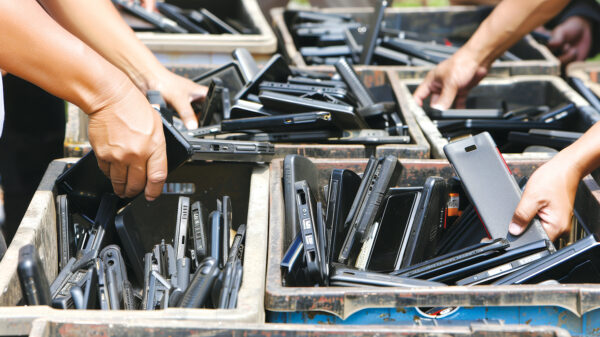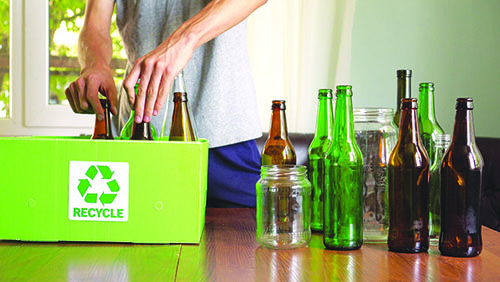by MAURA KELLER
It should come as no surprise that the growth of the sheet metal market can be both cyclical and regional depending on consumer market conditions, raw materials pricing, export/import conditions and project financing.
According to Tim Moore, senior underwriter at Atradius, the industry is seeing a potential boom for recyclers of scrap products. Atradius is a trade credit insurer that closely monitors the economic health of countries and individual businesses all around the world.
As Moore explained, many companies have depended on shipping scrap overseas, where typically it can be processed less expensively due to labor costs, then shipped back to the U.S. in an end product. However, the recent tariff increases on imported metal products from overseas is causing the U.S. end users of the product to source recycled product through U.S. companies.
“We see this as primarily due to pricing with a U.S. recycler, in spite of potential higher labor and processing costs, to still be cheaper than purchasing the same product at a 25 percent premium from overseas,” Moore said. “A potential problem, but still a good one to have, is the ability of U.S. recyclers to meet the increase in demand for U.S. recycled product since the number of plants and locations available for this process may not be sufficient to meet the needs of purchasers of recycled products.”
The sheet metal market has evolved considerably during the last decade. Ryan Lutz, senior project manager at Great American Group explained that over the past decade, applications for sheet metal, namely steel, aluminum and even stainless steel have grown considerably. Great American Group is a provider of asset appraisal, valuation advisory and disposition services. The firm assists companies, lenders, capital providers, private equity investors and professional service firms in maximizing the value of their assets. This includes such things as light weighting initiatives from the automotive and aerospace sectors resulting in increased R&D for lightweight but high strength steels, or increased adoption of aluminum as a viable automotive material, or the new/varying aluminum and stainless super alloys being produced for the aero sector to just the simple expansion of consumer tastes for stainless steel appliances. “Auto is probably the most publicly noticed sector of this advancement in materials,” Lutz said.
In fact, based on a study conducted by Ducker Worldwide, projections show that in the 10 year period from 2015 to 2025 traditional steel sheet will go from representing around 40 percent of the average vehicles weight down to 28 percent with much of that weight being reduced via the application of aluminum or advanced high strength steels.
“Sheet metal has so many applications, particularly in industrial manufacturing, that as the economy goes the sheet metal market goes,” Lutz said. “The growth in the U.S. after the recession – for the past 10 years – has driven the growth in the consumption and demand of the sheet metal market.”
As Lutz further explained, looking at the U.S. purchasing managers’ index, it’s been over 50 percent for more than the last 9 years running. This means there has been expansion in the economy for nine consecutive years, which has driven the demand and consumption of sheet metals.
Overall, the improvement in the economy means that metals as a whole are being consumed and the demand to produce them has increased. “Raw materials such as scrap metal have seen a significant demand increase over the past 10 years. We also need to keep in mind that 10 years ago we were just entering the recession with 2008 and 2009 demand falling off the cliff,” Lutz said.
Of course, the growth in sheet metals may result in decreased scrap metal yields when looking at car recycling. As more auto components consist of more electronics and composite materials, the metal yield will be decreased when they are put through the shredder.
“Additionally, it may mean recyclers, in the not so distant future, will have to make capital investments in more robust and efficient separator systems that will be able to handle the increased nonferrous content of vehicles and capitalize on the high dollar nonferrous content,” Lutz said.
Growing Segments
Founder and chief executive officer of IndustryStar Solutions, William Crane, said that demand for metal stampings, especially larger tonnage pieces, are at an all-time high. “There is currently limited capacity among stamping companies, globally, and stretched supply bases have left Tier I, II and III metal suppliers with strained supply chains that pose unique challenges to profitable expansion in a growing market,” Crane said.
There are a number of micro and macro trends that influence metal stamping suppliers’ current and future supply chain operations, but customer-buying habits are currently demanding more flexibility.
For instance, Crane said that vehicle platform components will continue to be designed utilizing lighter weight, nonferrous metals to address fuel economy, safety, and environmental issues.
“Innovative process capabilities to stamp difficult-to-form materials such as high strength steels and aluminum alloys will be a price to pay for both suppliers and their supply bases,” said Crane.
As he further explained, the economy is currently firing on all cylinders, which is creating an environment where suppliers are essentially able to sell everything they can produce.
“However, more and more foreword thinking manufacturers are rolling out ‘closed loop’ or ‘cradle to cradle’ supply chains where metal is recycled – used in the manufacturing of products – and then recycled and repeated,” Crane said.
Ford and Alcoa’s aluminum closed-loop system is a leading example of where more and more manufacturers will transition.
“This transition will be buyer driven and costly for early adopters, but it will be fueled by risk, cost and sustainability,” Crane said. “Those manufacturers that make the leap to cradle-to-cradle supply chains will stand to create sustainable competitive advantages in the years ahead.”
Sights Unseen
Currently the sheet metal market is strong – whether in construction, auto, or aerospace – there is good demand for sheet metal products. Lutz stressed that the future may lie in further R&D around making materials lighter and stronger and also substituting traditional materials such as sheet metal for composites.
“Additionally, the tariff situation has increased domestic demand for steels and thus boosted demand for recycled materials to service the U.S.’s mills,” Lutz said. “Another area to watch will be the further adoption of automation and robotics in sheet steel processing as this, in theory, will increase the yield use at the manufacturing location and result in declining industrial grade sheet scrap.
“Looking further down the line, less industrial scrap will need to be replenished,” Lutz said.
“Unfortunately, the U.S. is so immense that what happens in, say, the Northeast, may not be happening in the Southwest,” Moore said. “Building trends, home buyer trends and consumer product trends tend to differ across the country due to demographic differences in population and working environment. This can be affected by higher interest rates on such items as housing, auto and commercial CAPEX projects. Instead of buying new homes, cars or building new production facilities, trends show that people and companies will remodel rather than buy. In these cases, the need for sheet metal in large quantities will lessen and so will recycle opportunities.”
Moore said it is imperative that any sheet metal recycler or manufacturer pay attention not just to overall national trends, but focus on finding the areas where demographics are solid and additional business can be obtained. As Moore explained, “The big picture isn’t always the best picture as gems can be found in the most unlikely spots.”
Published in the October 2018 Edition







